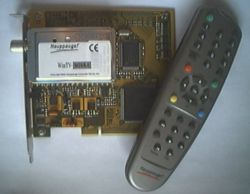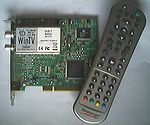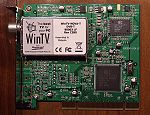Hauppauge WinTV-NOVA-T PCI: Difference between revisions
(some minor clean ups, and arrangement) |
m (switch big scary message to more suitable one) |
||
| (13 intermediate revisions by 6 users not shown) | |||
| Line 1: | Line 1: | ||
[[Hauppauge]] uses the ''WinTV-Nova'' moniker for their digital TV PCI cards that lack an onboard MPEG-2 decoder (i.e. the designation is used for their so |
[[Hauppauge]] uses the ''WinTV-Nova'' moniker for their digital TV PCI cards that lack an onboard MPEG-2 decoder (i.e. the designation is used for their so-called "budget" or software decoding cards). The -T suffix signifies that the device is for [[DVB-T]] reception. There have been two different types of card sold under the name WinTV-NOVA-T PCI. |
||
== Original Version(s) == |
== Original Version(s) == |
||
{{Important Notice|In 2.6.27 and possibly other kernel versions, the Alsa snd-aw2 driver will blindly grab all saa7146 devices preventing them from working. Blacklist the snd-aw2 driver to prevent this happening.}} |
|||
The first version(s), sold approximately before about July 2004, were based on the Philips [[Philips SAA7146|SAA7146]] interface chip and used either a Philips [[Philips TDA10046|TDA10046]] or [[Philips TDA10045|TDA10045]] or [[LSI L64781]] [[demodulator]]. |
|||
[[Image:Hauppauge_Nova-T_SAA7146.jpg|thumb|250px|WinTV-Nova-T PCI (TDA10045) with its remote control (model R808)]] |
|||
All of these variants are well-supported. The earliest cards featuring the LSI demodulator work "out of the box". For the receivers featuring the TDA demodulators, you need to identify your chip and see the [[Philips TDA10045|TDA10045]] or the [[Philips TDA10046|TDA10046]] pages. Since there doesn't appear to be a way to tell which one you have programatically you'll probably have to take the card out and look. |
|||
The first version(s), sold approximately between the later part of 2001 and before about July 2004, were based on the Philips [[Philips SAA7146|SAA7146]] interface chip and used either a Philips [[NXP TDA1004x|TDA10046]] or [[NXP TDA1004x|TDA10045]] or [[LSI L64781]] [[demodulator]]. |
|||
All of these variants are well-supported. The earliest cards featuring the LSI demodulator work "out of the box". For the receivers featuring the TDA demodulators, you need to identify your chip and see the TDA10045 or the TDA10046 section of the [[NXP TDA1004x|TDA1004x]] page. Since there doesn't appear to be a way to tell which one you have programatically you'll probably have to take the card out and look. |
|||
In most systems and for average users these cards work satisfactorily, the Linux drivers are well-tested and robust. Due to the limitations of the quite old-fashioned hardware there may exist some quirks when using multiple cards in a system. Tuning is slower than in competing designs. |
In most systems and for average users these cards work satisfactorily, the Linux drivers are well-tested and robust. Due to the limitations of the quite old-fashioned hardware there may exist some quirks when using multiple cards in a system. Tuning is slower than in competing designs. |
||
<br clear="all" /> |
|||
===Overview of Some Early Versions=== |
|||
* (l64781/Grundig 29504-401) |
|||
features: decoder, partialts |
|||
card driver: dvb-ttpci |
|||
interface: PCI |
|||
PCI device id: 1131:7146 |
|||
PCI subsystem id: 13c2:0008 |
|||
frontend 1: |
|||
tin box: Grundig 29504-401.04 |
|||
frontend driver: l64781 |
|||
demodulator location: separate |
|||
demodulator: LSI L64781 @0x55 |
|||
PLL: ?? @0x61 |
|||
Notes: Board has text "Sat-DVB Rev.: 1.6" |
|||
* (L64781/Grundig 29504-401(tsa5060)) |
|||
features: fullts |
|||
board markings: "S-DVB Data Rev 1.2" |
|||
card driver: budget |
|||
interface: PCI |
|||
PCI device id: 1131:7146 |
|||
PCI subsystem id: 13c2:1005 |
|||
Bridge: Philips SAA7146A |
|||
frontend 1: |
|||
tin box: Grundig 29504-401 |
|||
frontend driver: l64781 |
|||
demodulator location: tin box |
|||
demodulator: LSI l64781 @0x55 |
|||
PLL: Philips tda5060 @0x61 |
|||
Notes: |
|||
* (tda10045/Philips tdm1316l(tda6651tt) + TDA9889) |
|||
features: fullts |
|||
board markings: "B2T1110 Rev 1.1" |
|||
card driver: budget-ci |
|||
interface: PCI |
|||
PCI device id: 1131:7146 |
|||
PCI subsystem id: 13c2:1011 |
|||
Bridge: Philips SAA7146A |
|||
frontend 1: |
|||
tin box: Philips tdm1316l |
|||
frontend driver: tda1004x |
|||
demodulator location: separate |
|||
demodulator: Philips tda10045 @0x08 |
|||
PLL: Philips tda6651tt @0x63 |
|||
Notes: Need to disable the MC44BC374 (i2c:0x65) in the tin box. |
|||
SAW filter chip (TDA9889) is controlled by the tda10045's GPIO lines. |
|||
=== Remote control support issues === |
|||
Some remote controls may appear not to work despite having been supplied with the card. If you find that this is the case, read the rest of this section… |
|||
'''Method 1''' |
|||
This is the default for (some) Technotrend cards (PCI device IDs 1010 and 1017) and any "unknown" card. |
|||
''This method allows you to use almost any RC5 remote control with your card. Their device codes will be ignored. You will therefore need to make sure that only one remote control's signals are ever picked up by the card, and that you do not use a remote control which uses more than one device code - chances are that it has groups of keys with identical command codes, and the keys in any such group are indistinguishable from each other.'' |
|||
There are two ways to set this: you can add the following line to <tt>/etc/modules</tt>: |
|||
budget-ci rc5_device=255 |
|||
or the following line to a file in <tt>/etc/modprobe.d</tt>, e.g. <tt>00-local</tt>: |
|||
options budget-ci rc5_device=255 |
|||
The latter method has the advantage that the module is not loaded if no cards which need it are present. |
|||
'''Method 2''' |
|||
This is the default for some Hauppauge cards (PCI device IDs 100c, 100f, 1011 and 1012). The default device code is 31. |
|||
''This method restricts you to the supplied remote control (or any other which uses the same device code). Signals from other remote controls will be reported by the card, but the driver will ignore them. Remote controls which use more than one device code will have some non-functional keys.'' |
|||
Enable IR debugging for the card (with the driver module loaded): |
|||
# echo 1 > /sys/module/budget_ci/parameters/debug |
|||
Now, press a few keys on the remote control then: |
|||
# dmesg | tail |
|||
You'll see some lines of the form |
|||
budget_ci: received byte 0x3f |
|||
These lines (bit 6 clear; values between 0 and 0x3F or 0x80 and 0xBF) are important - plug that number into the following line: |
|||
# echo $((0x3f & 0x1f)) |
|||
You'll get the remote control's device code. There are two ways to set this: you can add the following line to <tt>/etc/modules</tt>: |
|||
budget-ci rc5_device=31 |
|||
or the following line to a file in <tt>/etc/modprobe.d</tt>, e.g. <tt>00-local</tt>: |
|||
options budget-ci rc5_device=31 |
|||
The latter method has the advantage that the module is not loaded if no cards which need it are present. |
|||
Two mappings have been reported "in the wild". |
|||
{| border=1 cellpadding=2 cellspacing=0 |
|||
! Identifier !! Device code |
|||
|- |
|||
| R808 OH/S1-1 || 26 |
|||
|- |
|||
| R808 OH/S1-3 || 31 |
|||
|} |
|||
== New Version == |
== New Version == |
||
[[Image:Hauppauge_Nova-T_Conexant.jpg|thumb|150px|right|WinTV-Nova-T PCI (Conexant) with its remote control (model A415)]] |
|||
[[Image:Nova-t-productcode-90003-rev-c2b0.jpg|150px|thumb|right|WinTV-Nova-T PCI model 90003 (rev c2b0)]] |
|||
This model is based on a [[Conexant]] [[Conexant CX2388x|CX2388x]]. |
|||
It should be automagically detected and work "out of the box" since kernel 2.6.12 and onwards. If by chance it is not, try getting the card to work by simply running "modprobe cx88_dvb". |
|||
<br clear="all" /> |
|||
This model is based on a [[Conexant]] [[Conexant cx2388x|cx2388x]]. Works "out of the box" with kernels 2.6.12 onwards. |
|||
===Overview of Revision with Product Code: 90002=== |
|||
* (cx22702/Thomson dtt7592(tua6034)) |
|||
features: fullts |
|||
board markings: sticker "DVB-T 90002", board "900000-03, HannStar MV-4 94V-O" |
|||
card driver: cx88 |
|||
interface: PCI |
|||
PCI device id: 14f1:8804 |
|||
PCI subsystem id: 0070:9002 |
|||
EEPROM: 128 bytes @0x50 |
|||
Bridge: Conexant CX2388x |
|||
frontend 1: |
|||
tin box: Thomson dtt7592 |
|||
frontend driver: cx22702 |
|||
demodulator location: separate |
|||
demodulator: Conexant cx22702 @0x43 |
|||
PLL: Infineon tua6034 @0x61 |
|||
Notes: |
|||
== See Also == |
|||
* [[Nova-T]] |
|||
[[Category:DVB-T]] |
[[Category:DVB-T PCI Cards]] |
||
[[Category:Hardware]] |
|||
Latest revision as of 20:16, 18 April 2010
Hauppauge uses the WinTV-Nova moniker for their digital TV PCI cards that lack an onboard MPEG-2 decoder (i.e. the designation is used for their so-called "budget" or software decoding cards). The -T suffix signifies that the device is for DVB-T reception. There have been two different types of card sold under the name WinTV-NOVA-T PCI.
Original Version(s)
The first version(s), sold approximately between the later part of 2001 and before about July 2004, were based on the Philips SAA7146 interface chip and used either a Philips TDA10046 or TDA10045 or LSI L64781 demodulator.
All of these variants are well-supported. The earliest cards featuring the LSI demodulator work "out of the box". For the receivers featuring the TDA demodulators, you need to identify your chip and see the TDA10045 or the TDA10046 section of the TDA1004x page. Since there doesn't appear to be a way to tell which one you have programatically you'll probably have to take the card out and look.
In most systems and for average users these cards work satisfactorily, the Linux drivers are well-tested and robust. Due to the limitations of the quite old-fashioned hardware there may exist some quirks when using multiple cards in a system. Tuning is slower than in competing designs.
Overview of Some Early Versions
- (l64781/Grundig 29504-401)
features: decoder, partialts card driver: dvb-ttpci interface: PCI PCI device id: 1131:7146 PCI subsystem id: 13c2:0008 frontend 1: tin box: Grundig 29504-401.04 frontend driver: l64781 demodulator location: separate demodulator: LSI L64781 @0x55 PLL: ?? @0x61 Notes: Board has text "Sat-DVB Rev.: 1.6"
- (L64781/Grundig 29504-401(tsa5060))
features: fullts board markings: "S-DVB Data Rev 1.2" card driver: budget interface: PCI PCI device id: 1131:7146 PCI subsystem id: 13c2:1005 Bridge: Philips SAA7146A frontend 1: tin box: Grundig 29504-401 frontend driver: l64781 demodulator location: tin box demodulator: LSI l64781 @0x55 PLL: Philips tda5060 @0x61 Notes:
- (tda10045/Philips tdm1316l(tda6651tt) + TDA9889)
features: fullts
board markings: "B2T1110 Rev 1.1"
card driver: budget-ci
interface: PCI
PCI device id: 1131:7146
PCI subsystem id: 13c2:1011
Bridge: Philips SAA7146A
frontend 1:
tin box: Philips tdm1316l
frontend driver: tda1004x
demodulator location: separate
demodulator: Philips tda10045 @0x08
PLL: Philips tda6651tt @0x63
Notes: Need to disable the MC44BC374 (i2c:0x65) in the tin box.
SAW filter chip (TDA9889) is controlled by the tda10045's GPIO lines.
Remote control support issues
Some remote controls may appear not to work despite having been supplied with the card. If you find that this is the case, read the rest of this section…
Method 1
This is the default for (some) Technotrend cards (PCI device IDs 1010 and 1017) and any "unknown" card.
This method allows you to use almost any RC5 remote control with your card. Their device codes will be ignored. You will therefore need to make sure that only one remote control's signals are ever picked up by the card, and that you do not use a remote control which uses more than one device code - chances are that it has groups of keys with identical command codes, and the keys in any such group are indistinguishable from each other.
There are two ways to set this: you can add the following line to /etc/modules:
budget-ci rc5_device=255
or the following line to a file in /etc/modprobe.d, e.g. 00-local:
options budget-ci rc5_device=255
The latter method has the advantage that the module is not loaded if no cards which need it are present.
Method 2
This is the default for some Hauppauge cards (PCI device IDs 100c, 100f, 1011 and 1012). The default device code is 31.
This method restricts you to the supplied remote control (or any other which uses the same device code). Signals from other remote controls will be reported by the card, but the driver will ignore them. Remote controls which use more than one device code will have some non-functional keys.
Enable IR debugging for the card (with the driver module loaded):
# echo 1 > /sys/module/budget_ci/parameters/debug
Now, press a few keys on the remote control then:
# dmesg | tail
You'll see some lines of the form
budget_ci: received byte 0x3f
These lines (bit 6 clear; values between 0 and 0x3F or 0x80 and 0xBF) are important - plug that number into the following line:
# echo $((0x3f & 0x1f))
You'll get the remote control's device code. There are two ways to set this: you can add the following line to /etc/modules:
budget-ci rc5_device=31
or the following line to a file in /etc/modprobe.d, e.g. 00-local:
options budget-ci rc5_device=31
The latter method has the advantage that the module is not loaded if no cards which need it are present.
Two mappings have been reported "in the wild".
| Identifier | Device code |
|---|---|
| R808 OH/S1-1 | 26 |
| R808 OH/S1-3 | 31 |
New Version
This model is based on a Conexant CX2388x.
It should be automagically detected and work "out of the box" since kernel 2.6.12 and onwards. If by chance it is not, try getting the card to work by simply running "modprobe cx88_dvb".
Overview of Revision with Product Code: 90002
- (cx22702/Thomson dtt7592(tua6034))
features: fullts board markings: sticker "DVB-T 90002", board "900000-03, HannStar MV-4 94V-O" card driver: cx88 interface: PCI PCI device id: 14f1:8804 PCI subsystem id: 0070:9002 EEPROM: 128 bytes @0x50 Bridge: Conexant CX2388x frontend 1: tin box: Thomson dtt7592 frontend driver: cx22702 demodulator location: separate demodulator: Conexant cx22702 @0x43 PLL: Infineon tua6034 @0x61 Notes:



